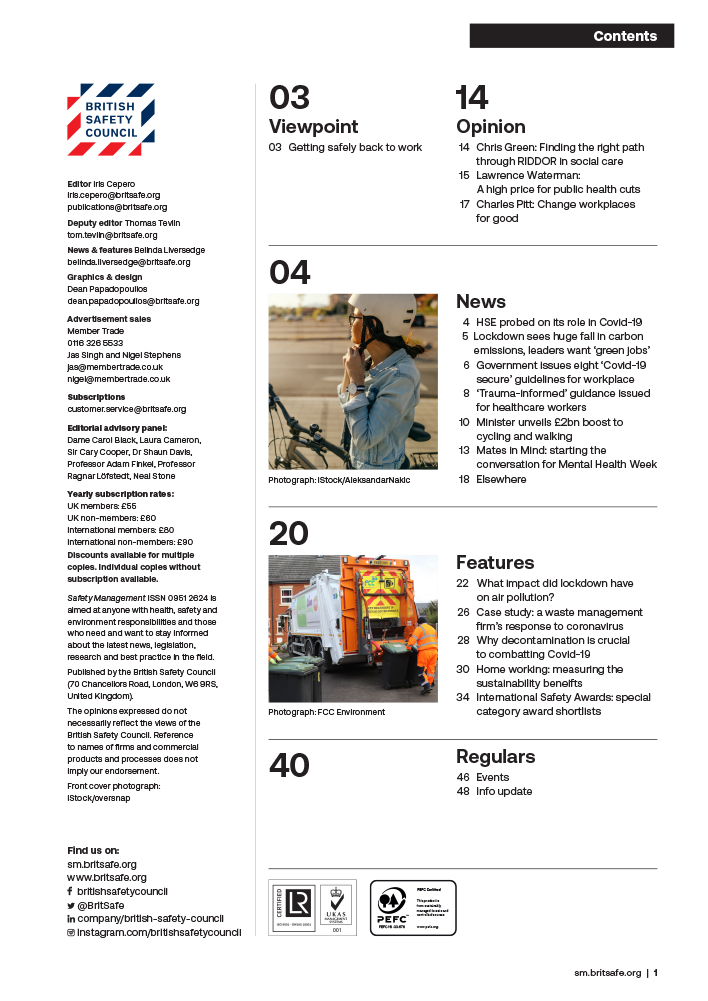By embedding social sustainability principles into their policies and operations, organisations can not only improve quality of life for their employees, workers in their supply chains and the communities they interact with, but boost their business resilience, productivity and reputation.
Features
Why social sustainability should be a priority for health, safety, environmental and compliance professionals
What is social sustainability?
Social sustainability is a core pillar of sustainable development that ensures individuals and communities can live fulfilling, healthy and equitable lives – both now and in the future. Unlike environmental sustainability, which focuses on preserving natural resources, or economic sustainability, which ensures long-term financial viability, social sustainability is centred on people. It encompasses human rights, fair employment practices, diversity and inclusion, access to essential services and overall wellbeing.
Social sustainability aligns closely with the United Nations Sustainable Development Goals, particularly Goal 3 (Good Health and Well-being), Goal 5 (Gender Equality), Goal 8 (Decent Work and Economic Growth) and Goal 10 (Reduced Inequalities).
 Social sustainability encompasses human rights, fair employment practices, diversity and inclusion, access to essential services and overall wellbeing. Photograph: iStock
Social sustainability encompasses human rights, fair employment practices, diversity and inclusion, access to essential services and overall wellbeing. Photograph: iStock
However, all of the goals have a human element too. For example, Goal 6 (Clean Water and Sanitation) has significant environmental considerations connected with resource management, infrastructure and pollution prevention, but it is also about having equitable access to clean water for all.
The concept is also well demonstrated through a framework such as Doughnut Economics, which was developed by economist Kate Raworth and aims to balance human needs and environmental sustainability.
It reimagines traditional economic thinking by moving away from endless growth and focusing instead on creating a safe and just space for humanity – between the social foundation and ecological ceiling. Falling below the social foundation means people are living in deprivation, while going beyond the ecological ceiling of planetary boundaries like climate change, biodiversity loss and pollution leads to environmental degradation, and ultimately the planet not being able to support human life.
 Credit: Kate Raworth and Christian Guthier. CC-BY-SA 4.0. Citation: Raworth, K. (2017), Doughnut Economics: seven ways to think like a 21st century economist. London: Penguin Random House. Doughnut Economics Action Lab, doughnuteconomics.org
Credit: Kate Raworth and Christian Guthier. CC-BY-SA 4.0. Citation: Raworth, K. (2017), Doughnut Economics: seven ways to think like a 21st century economist. London: Penguin Random House. Doughnut Economics Action Lab, doughnuteconomics.org
Businesses, governments and civil society organisations can all have a role in making this a reality by embedding social sustainability into their policies and operations, ensuring that economic growth and environmental protection do not come at the cost of social equity and wellbeing.
In practical terms, organisations that are committed to social sustainability integrate
ethical employment practices, ensure fair wages, foster safe and inclusive workplaces, engage meaningfully with local communities and uphold human rights across supply chains. These efforts not only improve quality of life for individuals but also enhance business resilience, productivity and reputation in an increasingly socially conscious yet turbulent global economy.
How does social sustainability link with health and safety?
Social sustainability is interconnected with both environmental sustainability and occupational safety and health (OSH).
A safe and healthy workplace is a fundamental aspect of social responsibility, ensuring that employees are protected from both physical hazards and psychosocial risks such as stress, burnout and workplace discrimination. Organisations can incorporate social sustainability principles in OSH policies by:
- Ensuring fair working conditions: providing adequate wages, job security, and work–life balance reduces stress and improves overall safety culture.
Embedding safety in corporate culture: encouraging open communication about workplace hazards and supporting employee engagement in safety decisions leads to better risk management. - Addressing environmental risks: ensuring air quality, ventilation and noise reduction in workplaces protects employees from long-term health effects caused by environmental factors.
- Promote mental and physical wellbeing: implementing Employee Assistance Programmes, flexible and inclusive work policies and health initiatives helps prevent workplace-related illnesses.
All of these actions are crucial to consider and are often a regulatory requirement, especially for businesses based in the UK and Europe. However, organisations that apply these principles further within the supply chain can have an impact on social sustainability beyond their direct contract by sending clear signals to the suppliers, contractors and the wider markets to improve their operations in this area.
SHEQ professionals’ role in social sustainability
Many professionals within safety, health, environment and compliance (SHEQ) roles will become increasingly involved in social sustainability activities, both directly and indirectly.
In many organisations, they will be involved in developing policies and processes to ensure safety and compliance – for example, on issues such as climate resilience within workplace safety, or heat stress management programmes in industries affected by rising temperatures. They are therefore able to consider the impacts on staff and the wider community as well as prioritising the mitigations and adaptations that benefit people in other ways, such as flexible working and ensuring regular breaks.
Global supply chains are increasingly vulnerable to disruptions whether due to economic instability, climate-related disasters or labour shortages. This highlights the need for resilient, ethical and socially responsible procurement strategies.
 Organisations can incorporate social sustainability principles in OSH policies by ensuring fair working conditions. Photograph: iStock
Organisations can incorporate social sustainability principles in OSH policies by ensuring fair working conditions. Photograph: iStock
SHEQ professionals are likely be involved in the development and due diligence of supply chains. This might be through direct involvement in procurement processes for a specific product or service but more importantly they might be involved in the development of corporate responsible procurement policies. These professionals therefore have an opportunity to highlight the need to consider key issues and mitigate risks such as market volatility, modern slavery and unethical procurement practices.
Addressing modern slavery – a key issue in many global supply chains – requires organisations to trace their supply sources, implement strict contractual obligations and engage in supplier audits to ensure compliance with human rights and employment laws.
Additionally, responsible procurement involves sourcing from suppliers that uphold fair wages and safe working conditions, and hold sustainability and ethical certifications, such as Fair Trade, B Corp, PAS 808 (Purpose driven organisation) and ISO 2600 (Social responsibility). As many of the professionals traditionally involved with OSH, environmental and quality standards will have invaluable skills and expertise in improvement, monitoring, auditing and evaluation of these standards, they should be a core part of the teams developing policies to embed social sustainability into corporate procurement policies.
Companies that fail to integrate social sustainability into their supply chains risk reputational damage, regulatory penalties and operational disruptions, whereas those that proactively address these challenges can build stronger, more resilient and ethical supply networks that benefit both people and business longevity.
What can organisations and professionals do to incorporate the concepts into their work
To effectively integrate social sustainability into workplace policies, processes and professionals’ day-to-day roles – particularly those in OSH, environmental management and corporate responsibility – organisations must adopt proactive, strategic approaches that go beyond compliance. This means embedding social responsibility principles into decision-making, operations and workforce engagement.
1. Embedding social sustainability into corporate strategy
Organisations should make social sustainability a core business priority rather than an afterthought. This involves:
- Aligning company policies with global frameworks like the UN Sustainable Development Goals or the UN Global Compact. Consider how and where your operations have a material impact. This might have already been carried out for the environmental impacts of the organisation.
- Developing clear targets for social impact, such as diversity, equality and inclusion, fair wages and community investment. This might require looking at a variety of metrics and data sources. It is key that this is captured in a structured and replicable way to ensure tracking over time is possible.
- Implementing corporate social responsibility programmes that go beyond regulatory compliance. Consider the additionality (the extent to which something happens as a result of an intervention that would not have occurred in the absence of the intervention) and legacy impacts.
2. Strengthening worker wellbeing and safety programmes
OSH professionals play a crucial role in bridging workplace wellbeing, which is one of the core parts of social sustainability and workplace safety. To create happier, healthier and safer workplaces, organisations should:
- Expand health and safety training to include psychosocial risks, mental health awareness and diversity-sensitive safety protocols.
- Promote fair working conditions by ensuring equitable pay, ethical employment practices and safe working hours to prevent burnout.
- Encourage open reporting cultures where employees feel safe to report hazards, discrimination or unfair treatment without fear of retaliation.
3. Integrating social and environmental sustainability
Environmental and social sustainability are deeply linked, and organisations should approach sustainability holistically:
- Adopt sustainable procurement policies that ensure ethical employment practices in supply chains while minimising environmental harm.
- Design safer and greener workplaces, incorporating nature and plants, natural light, clean air and energy-efficient designs to tackle climate risks, adaptation and resilience as well as worker wellbeing.
- Implement climate resilience measures such as heat stress management and disaster preparedness in workplaces vulnerable to climate risks to protect your workforce and mitigate any impacts.
4. Measuring and reporting social impact
To track progress and improve accountability, professionals should use data-driven approaches to measure social impact:
- Conduct employee wellbeing surveys and audits to assess job satisfaction, safety perceptions and overall workplace culture.
- Utilise social value measurement tools like Social Return on Investment (SROI), WELLBY (Wellbeing-Adjusted Life Years) and the Social Value Portal framework to assess the impact of projects or initiatives.
- Report transparently by integrating Environmental, Social, and Governance (ESG) metrics into corporate sustainability reports, showing progress on key issues relevant to your organisation and your workforce.
5. Encouraging leadership and industry collaboration
For long-term success, all sustainability must be driven by leadership and supported by cross-industry collaboration:
- Train leaders, managers and executives on the importance of social sustainability and its impact on business performance.
- Join industry organisations and voluntary initiatives such as IEMA, Social Value International and the UN Global Compact to exchange best practices and drive collective action.
- Partner with local communities and policymakers to align initiatives with broader social development goals.
Conclusions
By embedding social sustainability into workplace safety, environmental policies, and corporate strategies, professionals across different roles and functions can create healthier, more inclusive, and more resilient organisations. Whether through ethical employment practices, mental health initiatives, or sustainable procurement, the impact extends beyond the workplace – helping to build a fairer, more sustainable world for future generations.
Agnes Chruszcz is IEMA’s policy and engagement lead for circular economy and social sustainability.
IEMA has published The Social Sustainability 101, a new guide that explains the key terms and concepts of social sustainability and provides guidance on delivery methods for social sustainability in organisations. The document also includes an introduction to the key legislation, metrics and further reading resources to further deepen understanding of how social sustainability fits into wider frameworks and concepts within sustainable development.
To purchase or download the guide, and for further information on social sustainability, see:
iema.net/resources/blogs/2025/jan/putting-the-s-in-esg-iemas-social-sustainability-101/
iema.net/policy-and-practice/social-sustainability/
For more information on IEMA’s work, see:
iema.net
linkedin.com/company/iema---institute-of-environmental-management-and-assessment/
@iemanet


FEATURES

India’s path to net zero: a work in progress
By Orchie Bandyopadhyay on 08 April 2025
India is implementing a variety of clean energy measures to hit its target of net zero greenhouse gas emissions by 2070, including plans to rapidly scale up the generation of nuclear power. However, climate experts say significant finance will be required from developed countries to phase out coal power, accelerate renewables deployment and expand the national electricity grid.

Too hot to handle: early arrival of heatwaves in India sparks calls for action to protect workers and the public
By Orchie Bandyopadhyay on 08 April 2025
Temperatures in India in February 2025 were the hottest since records began over a century ago, prompting warnings the country needs to urgently step up efforts to protect both workers and the general population from the health risks posed by extreme heat and humidity.

